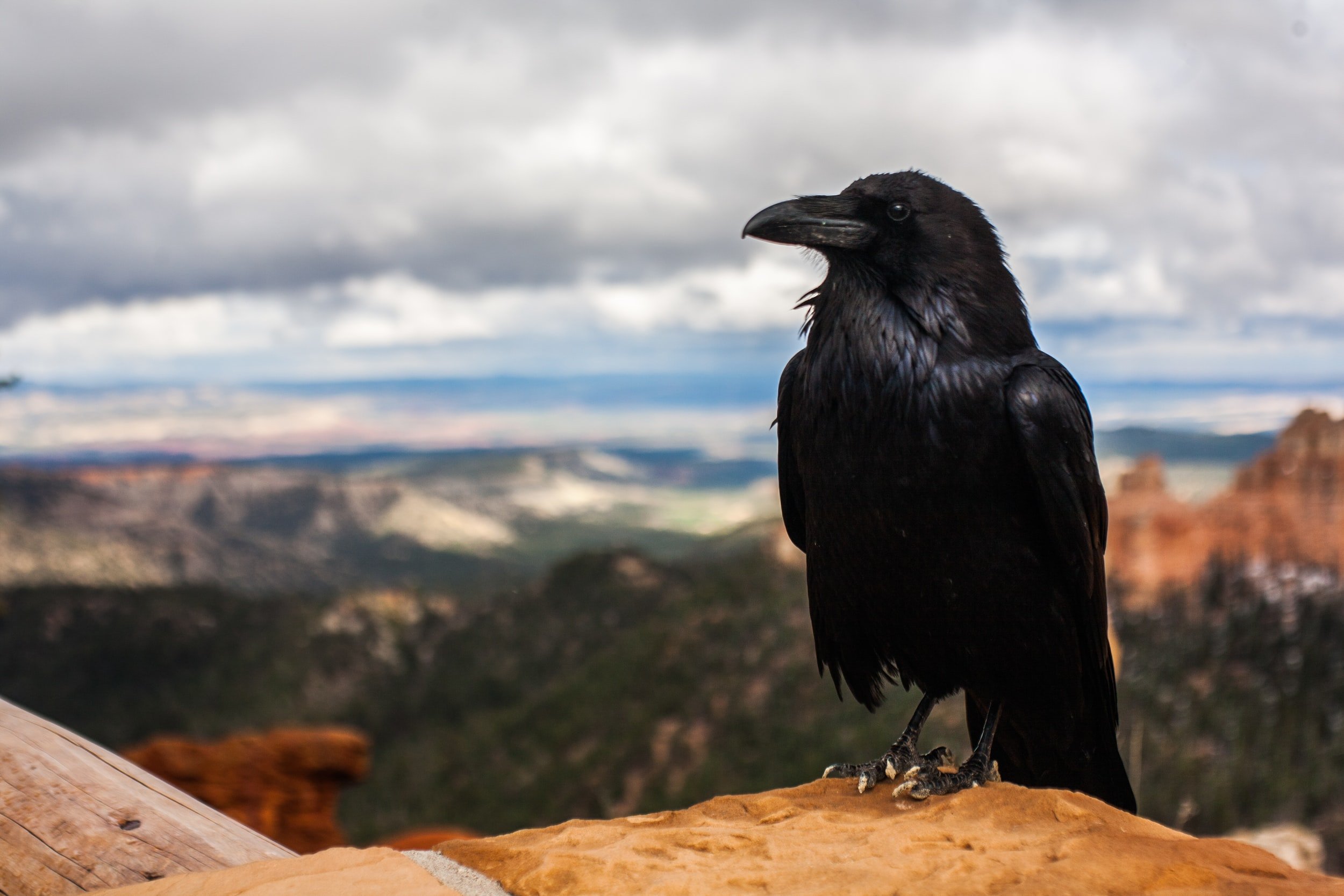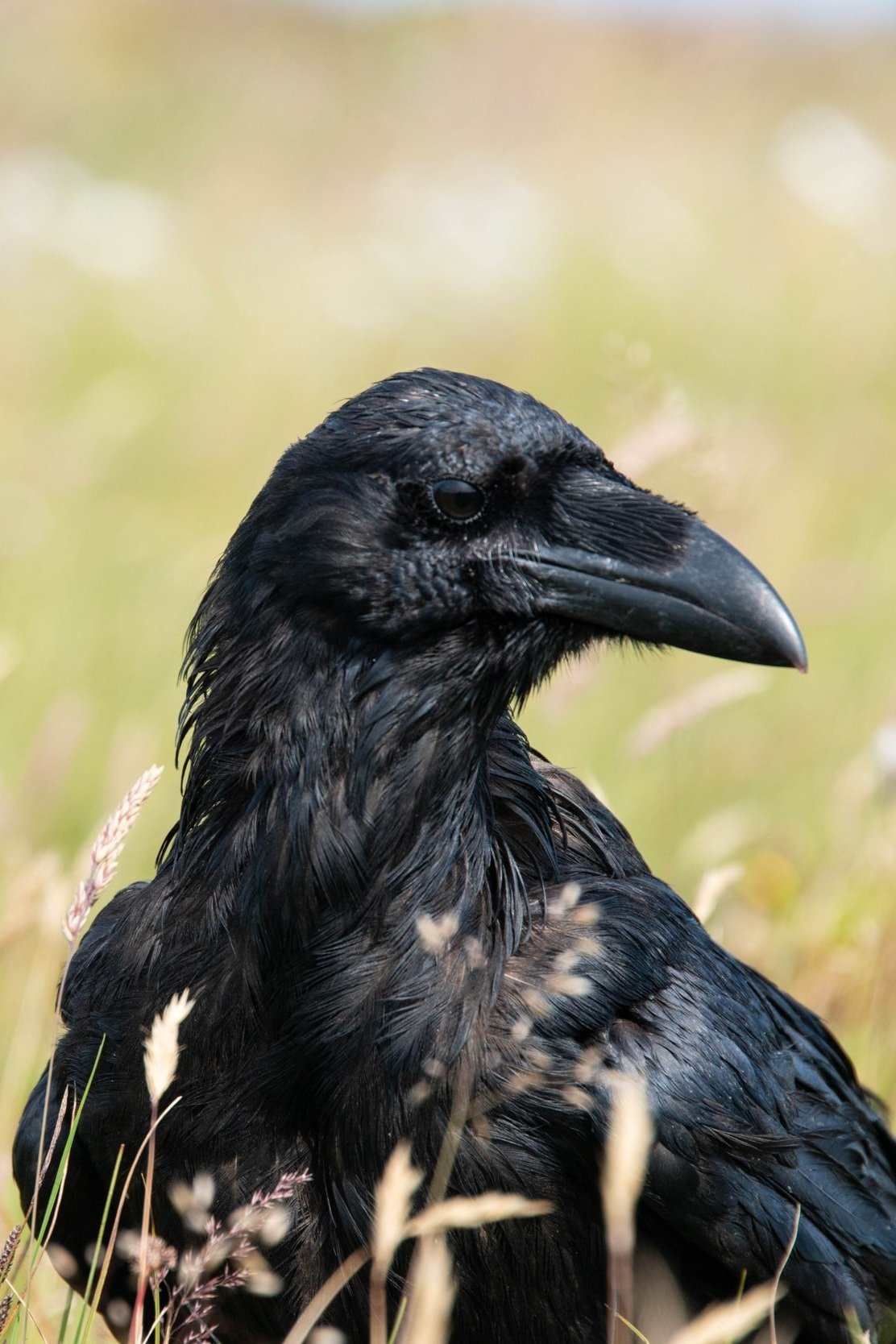
The Common Raven Lesson
What sound do you think ravens make? Let’s hear it!
CALLS
Common Ravens make many different kinds of calls varying from a low, gurgling croak to harsh grating sounds and shrill alarm calls. Scientists have placed their vocalizations into as many as 33 different categories based on sound and context. The most commonly heard is the classic gurgling croak, rising in pitch and seeming to come from the back of the throat. It’s much deeper and more musical than a crow’s simple, scratchy caw. Ravens make this call often. It’s audible for more than a mile, and ravens often give it in response to other ravens they hear in the distance. Among their other calls, ravens make short, repeated, shrill calls when chasing predators or trespassers, and deep, rasping calls when their nests are disturbed. Dominant females sometimes make a rapid series of 12 or so loud knocking sounds that lasts about a second. Common Ravens can mimic other birds, and when raised in captivity can even be taught words.
OTHER SOUNDS
Displaying males and females snap their beaks audibly. Females performing the rapid knocking call often end it with a bill snap.
Details
COMMON NAME: Common Raven
SCIENTIFIC NAME: Corvus corax
TYPE: Birds
DIET: Omnivore
GROUP NAME: Flock
AVERAGE LIFE SPAN IN THE WILD: 13 years
SIZE: 24 to 26 inches; wingspan: 3.8 to 4.7 feet
WEIGHT: 2.3 pounds
Where do they fall on the food chain?
Known as scavengers, ravens are also effective hunters that sometimes use cooperative techniques. Teams of ravens have been known to hunt down game too large for a single bird. They also prey on eggs and nestlings of other birds, such as coastal seabirds, as well as rodents, grains, worms, and insects. Ravens do dine on carrion and sometimes on human garbage.
Intelligence
Scientists and casual observers alike have known for years that ravens and their corvid relatives are extremely smart. But most studies use single experiments that provide a limited view of their overall intelligence. “Quite often, in single tasks, you’re just testing whether the bird can understand that you’re hiding something,” says Simone Pika, a cognitive scientist at Osnabrück University in Germany.
A new study that that tries to address that deficit provides some of the best proof yet that ravens, including young birds of just four months of age, have certain types of smarts that are on par with those of adult great apes. The brainy birds performed just as well as chimpanzees and orangutans across a broad array of tasks designed to measure intelligence. “We now have very strong evidence to say that, at least in the tasks we used, ravens are very similar to great apes,” says Pika, lead author of the study. “Across a whole spectrum of cognitive skills, their intelligence is really quite amazing.” The findings, published in Scientific Reports, add to a growing body of evidence indicating that impressive cognitive skills are not solely the domain of primates but occur in certain species across the animal kingdom.
What’s the difference between a crow and a raven?
Common Raven (Corvus corax)
American Crow (Corvus brachyrhynchos)
Ravens differ from crows in appearance by their larger bill, tail shape, flight pattern and by their large size. Ravens are as big as Red-tailed Hawks, and crows are about the size of pigeons.
Ravens are uncommon in populated urban areas. If you see a "really big crow" in the city, the chances are good that it really is a crow and not a raven.
Tail Feathers: Ravens have wedge-shaped tails and crows have fan-shaped tails. When you see the bird flying overhead, you can often get a good look at the shape of the tail. (Drawing by Jenifer Rees. Courtesy of WDFW.)
Common ravens have a well-developed ruff of feathers on the throat, which are called 'hackles' (see photo).
Ravens soar more than crows. If you see a "crow" soaring for more than a few seconds, take another look - it might be a raven. Common Ravens can do a somersault in flight and even fly upside down. Ravens are longer necked in flight than crows.
Raven wings are shaped differently than are crow wings, with longer primaries ("fingers") with more slotting between them.
Ravens have wedge-shaped tails and crows have fan-shaped tails (see drawing).
So where are they???
Ranges for the common raven and American crow shown on this map were adapted from each species’ account on All About Birds.
Determining whether the Corvid you see is a raven or a crow can be as easy as checking the map above and see which species is expected to occur in that particular region.
In most of the U.S., the common raven’s range does not overlap with that of the American crow.
The ranges of the Common raven and American crow do overlap and are found in the region in the Appalachian Mountains of the eastern US and the northern portions of Minnesota, Wisconsin, Michigan, New York, Vermont, and Maine, where both the raven and the crow can be found in the same region.
These two corvids’ ranges widely overlap in most of Canada and the Western US (see map).






